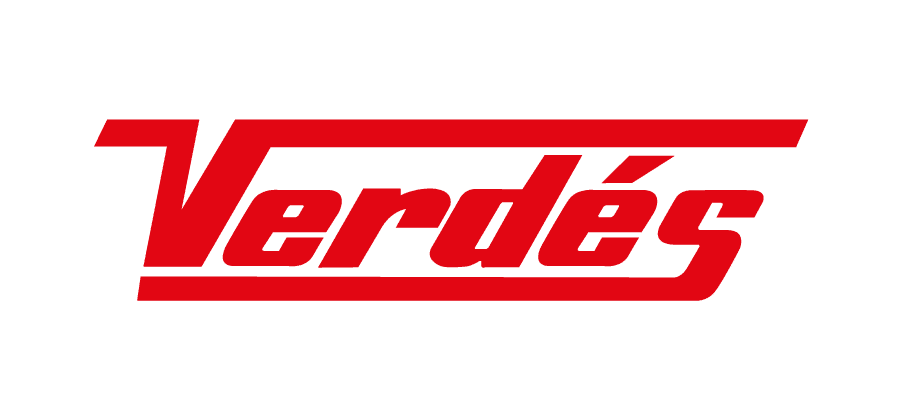21 Nov Verdés: Innovation & Improvements
We have on many occasions given enough emphasis to the range Talleres Felipe Verdés, S.A. offers its clients and to its capacity to adapt to any kind of clay type and condition, whether by means of dry grinding with Hammer or Pendulum Mills or wet grinding using more common or universal processes, such as Wet Pan Mills or Disintegrators.
In this article, we will give a quick overview of the company’s innovation and improvement policy, both in terms of the design and features of Machines designed and manufactured by Verdés.
Our sector is known for its conservatism and, once the first few units have been designed and built, it is common for manufacturers’ Equipment to go unchanged for decades, discounting the small, really imperceptible improvements they collect over time.
Verdés decided to differentiate itself from its competitors and commenced a multitask project with the prime objective of redesigning its whole Equipment range, family by family, considering those improvements to be incorporated in each case year on year, but also with its sights set on the most ambitious horizon reached by redesigned the machines themselves, including the processes for manufacturing them.
As such, up to now, Verdés has completely redesigned its range of Hammer Mills, MAGNA Extruders, OPTIMA Roller Mills and Pendulum Mills and is also in the process of redesigning its Circular Screen Feeders. It has also launched onto the market two new items of Laboratory Machines, the Disintegrator model 120 and the Hammer Mill model 030 to complement its current range.
The Hammer Mill may be one of the machines to have undergone the most radical transformation. This type of machine had traditionally suffered from a difficulty: its maintenance. Based on this reputation, it has always been an undervalued item of equipment, even though its effectiveness and grinding capacity are unquestionable. What Verdés did was to focus precisely on easing its maintenance tasks and, to do this, it redesigned the mill so that:
- All its parts are easily accessible to the operator.
- Auxiliary mechanical or lifting means are not needed for maintenance tasks.
- The inside of the mill can be visually inspected at any time without difficulty and with no loss in production.
And with the aim of reducing the cost per ton processed, work is also being carried out to improve the day-to-day behavior and service life of wear parts, whether by redesigning part geometries, incorporating new, more resistant materials or simply reducing costs.
Apart from the above, the new Mill design reduces irregular wear and, above all, makes it a more flexible machine. Forced feeding, flow control, electrical resistances and the availability of different grid or bar types and measures mean higher percentage humidity can be accepted, which can reach 12-14% in some cases, depending on clay type.
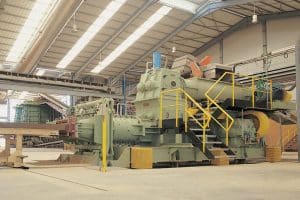
The next family of machines to be subjected to this total revision process was the COMBI, which became the new MAGNA De-Airing Extruder range at the end of 2013. The change did not affect the general machine concept in this case. This still consists of two Mixing and Extruding bodies with independent reducers.
Verdés remained faithful to the classic tandem reducers with parallel shafts, case hardened and ground helical gears to ensure secure, progressive transmission and quiet operation, long durability and, of course, to make maintenance easier.
Both the mixer body, which is now modular, and the new geometry of its adjustable orientation mixing knives are built to minimize consumption and the wear of its components by improving mixing efficiency, thanks additionally to the “knife-on-knife” effect characteristic of all Verdés’ mixers.
The external geometry of the machine has changed. The MAGNA’s larger vacuum chamber and the accessibility it provides for access, inspection and maintenance can be seen clearly.
The augers body is now hermetically sealed, as the protectors are secured to the body by means of a new fixing system with a bolt-free system that avoids any risk of vacuum leaks. Articulation and opening of the augers body is by means of hinges mounted on the machine body itself, so as to offer better access to the screws and rear guards, greatly easing maintenance and cleaning tasks.

Verdés continues to offer Cylindrical, Conical and Extra-Conical auger configurations, depending on need and clay type. Although the standard model remains true to chrome alloy, Verdés has a wide range extending to other types of finishes and coatings, whether surface chrome plating, chrome or tungsten carbide coatings or a combination of the two. This means working conditions can be adapted to the demands of each clay and each format, as well as to each user’s preferences anywhere in the world.
In summary, the general design of the MAGNA De-Airing Extruders is based on the tried and tested COMBIs, incorporating substantial improvements aimed at:
- Reducing power consumption.
- Providing greater wear part durability.
- Increasing accessibility for inspection and maintenance tasks.
- Expanding versatility in the case of different pressure and moisture conditions.
- Extending flexibility to produce all kinds of ceramic formats on a single line.
These improvements have been widely acknowledged by the market and, until now, apart from other COMBI and MONOBLOC models, a total of 18 units have been sold, mainly to countries in the C.I.S. Area, North Africa, the Middle East and South-East Asia.
MONOBLOC De-Airing Extruders, in turn, remain valid. Indeed, they continue to be an important asset in the Verdés range and a reference for many Single Product facilities, where the principle of simplicity is crucial.

Given that they work based on a single geared reducer box, they are machines with fewer moving parts, lower operating cost and reduced power consumption, are very easy to maintain and highly reliable, which will shortly incorporate some of the improvements already proven in the MAGNA series.
The year 2014 saw the release of a whole new range of Roller Mills, the OPTIMA range, aimed at gradually replacing the conventional 080 series Roller Mills, as well as the 090 series Hinged models.

The new OPTIMA roller mills are built in sizes ranging from working widths of 600 to 1400 mm, always with roller shells of Ø 1000 mm and in three versions, “B”, “H” and “R”. Working pressure is hydraulic in all cases.
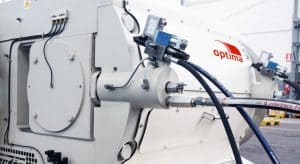
They are basically more robust machines than their predecessors. The bedplate is built with electro-welded steel and is, as a whole, a more compact design. Separation between roller shells is mechanical in the “B” models, while in “H” and “R” models it is assisted by an automatic system that acts on the bearing holders simultaneously by means of double acting hydraulic pistons. The system is regulated from a touch screen and offers adjustment reliability of 0.01 mm.
Ease of maintenance was also taken into account and, for example, the procedure for changing the roller shells has been improved so that it is no longer necessary to disassemble the shaft assembly, so preventing possible damage to the bearings.
The “B” and “H” models are appropriate for ensuring a separation between roller shells of 0.8mm with a working pressure of 50 kg/mm, while the “R” version, with a clamping pressure 60 kg/mm, is specifically designed to work at 0.6mm constantly.
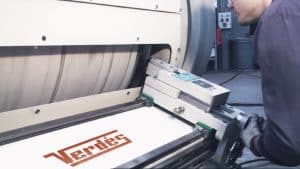
The grinding lathes have also been completely redesigned. They are built on electrically welded steel bedplates. The tool moves on hardened steel rails and has its own frequency converter to control drive speed, as well as a clutch and rapid drive system.
2015 was the year of the Pendulum Mill. Initially designed in the early 1970s, it is the type of Machine and Facility with the greatest chance of applying to other sectors and products outside the Heavy Clay industry.
Like other Machines in Verdés’ range, its operating principle has not changed and is based on the rotation of the pendulum rollers against a grinding ring. Rotational inertia itself generates the necessary pressure to progressively reduce the size of the particles until they are carried away by the pneumatic suction system to a separator or classifier, which rejects the coarse particles and returns them to the grinding chamber again.
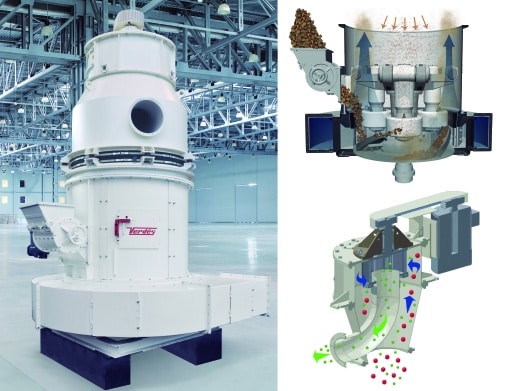
Verdés’ Pendulum Mills have, over the years, also progressively incorporated numerous changes and improvements, the time to review which had come. In fact, this involved redesigning a whole system, as the Pendulum Mill is just one part of a set of equally important elements, such as the classifier, the filter, control equipment, ventilation circuit, etc., to make it versatile and suitable for fine grinding of various products (non-ferrous minerals). In the ceramics sphere, they are especially suitable for grinding clays for producing high value added products, such as tiles, facebricks and ventilated façades, as they guarantee impurity-free surface finishes of extremely high quality, to the point where they are used in some countries to produce ceramic floor tiles.
The new Pendulum Mills:
- Accept input sizes up to 50 mm.
- Make it possible to ensure particle sizes of less than 20 µm.
- Accept clays of up to 6 Mohs.
- Have built-in drying.
- Improve accessibility to the grinding chamber and to all the moving parts.
Verdés’ new Pendulum Mills are complemented by a range of vertical rotor ALPHA Classifiers, providing maximum cutting precision and low specific power consumption.
2016 is the year of the Circular Screen Feeders. These Machines have a great reputation and prestige, above all in Central and North European markets. Also known as “vertical mixers”, they are particularly suitable for facilities where large amounts of cuttings from the mixing zone need to be reprocessed, preferably when extrusion is performed at medium or low pressure. The new range of these Verdés Circular Screen Feeders is being redesigned with ideal clay homogenization and mixing in mind, with a new rotor and blade geometry.
Verdés is working on a new compact, multi-function design to give high performance combined with low power consumption. We can reveal that it will incorporate a large mixing trough and a new arrangement of its peripheral grilles to ease accessibility for maintenance tasks, although its final features and advantages remain to be defined in the coming months.
Verdés is very clear on the challenges its Clients face and is fully committed to ensuring that all the machines that makes up its range provides solutions to ever increasing needs for reliability, low power consumption and easy, economic maintenance.
